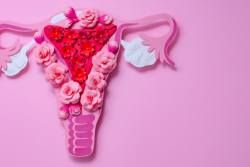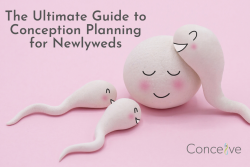Estrogen has a bad reputation when it comes to women’s health. We hear a lot about how too much estrogen can put our hormones out of balance, but the truth is that it’s a bit of a Goldilocks hormone. We need just the right amount at different times of our monthly cycle — and even at different times in our lives.
Looking at both sides of the equation, too little can lead to menopause symptoms, amenorrhea (not getting your period), thin uterine lining, heart disease, and osteoporosis. Too much can contribute to certain cancers, heavy periods, and contribute to fibroids and endometriosis. Both (too low or too high estrogen) impact your fertility.
Today, we’re going to talk about the effect of HIGH estrogen on fertility.
First, what are some symptoms of high estrogen?
Take a look at this list, but note that these points are very non-specific. I would not want to jump to diagnose a patient with high estrogen based on this list alone.
Breast tenderness and/or distension
Fibrocystic breasts
Cyclical headaches or migraines
Irregular periods
Bloating and water retention
Fibroids
Endometriosis
Irritability
Recurrent vaginal yeast infections
Acne
Decreased sex drive
Weight gain
Brain fog
Allergies
Second, a lot of these issues come from the relative amount of estrogen to progesterone. You may have normal estrogen levels when tested, but if progesterone is low you will have a functional imbalance that looks like “high” estrogen symptoms. The proper term would be a “relative estrogen dominance,” but for simplicity, I will refer to these scenarios as “high.”
Do high estrogen levels impact fertility?
You could have seemingly normal menstrual cycles, but are not ovulating.
Not ovulating can be caused by several different things as well as estrogen dominance, but we’re going to focus on the estrogen. Usually, if we look closer and have an ultrasound done, we would see a cyst that has formed instead of a healthy follicle with an egg inside. On cycle day 3, we shouldn’t have a cyst or estrogen over >300 pmol/L.
Once you’re working with a fertility clinic and those things are being measured, you may end up with cancelled IVF cycles until the cyst goes away and estrogen normalizes. I work with women to speed that process up and prevent future cysts to form.
This is important even if you’re not working with a fertility clinic because you could have these mini cysts happening that you would never know about unless you’re getting regular ultrasounds (like in a fertility clinic). They are not large enough to cause symptoms, and if they don’t burst you wouldn’t know about them. You would likely still be having periods, though they may not be regular, and you would not be ovulating normally.
Irregular cycles
Makes it harder to time intercourse if you ovulate at widely different and possibly unpredictable times each month. The irregular cycles can be caused by estrogen dominant pictures like cysts, uterine polyps, fibroids, or other related hormone disruption (like PCOS and thyroid dysregulation).
Heavy flow + crampy luteal phase
Since high estrogen thickens your uterine lining during the first half of your cycle, you have more to shed during your period. This causes heavy, and often crampy and painful, periods. Having a heavy flow itself won’t limit fertility, but the overall ratio of estrogen to progesterone matters for the endometrial receptivity for an embryo. Think of progesterone as calming the waters for a ship to dock. You need the relative amount of estrogen to progesterone to be just right during that implantation window for an embryo to snuggle in. If a patient tells me they are really crampy through their luteal phase, I will want to know what their progesterone looks like on testing.
What if you’re going through IVF treatment?
Most clinics are now doing frozen embryo transfers.
In fresh transfers, there is evidence to show that if estrogen levels are over 20,000 pmol/L on the day of the transfer (right after you did an egg retrieval — where hormones are still high from the ovarian stimulation phase) pregnancy rates are actually lower. To remedy this, many REI’s will choose to forgo a fresh transfer and freeze all embryos for a future transfer. This is partially why we have seen such an increase in Frozen Embryo Transfers.
Another study found a significant increase in pregnancy rates in women undergoing fresh embryo transfers, whose estrogen was 7000 pmol/L on egg retrieval day, compared to 19,000 pmol/L on egg retrieval day. The pregnancy rate was 64% for women with lower estrogen, compared to only 24%. In this particular study, they achieved the lower estrogen by using a lower dose of stimulating medicine in the first place, in a population found to be “high responders” to the stimulation medication in a previous failed cycle. High estrogen in the follicular phase leading up to egg retrieval is known to inhibit embryo implantation later on.
So we have a mix of data that is important to women on either end of the trying to conceive spectrum: those trying at home, through to those trying using IVF.
How to Lower Excess Estrogen
Lowering that estrogen is a fine balance. Some of the most common supplements you would see on the market for “detoxing” estrogen are NOT safe to use with fertility medication — and can actually affect the efficacy of fertility medications — so please consult with a Naturopathic Doctor who is trained in nutraceutical-plant-drug interaction.
The safest direction to go is by increasing fiber, eliminating alcohol, addressing gut health and supporting healthy gut bacteria, and decreasing xenoestrogens, which are chemicals like BPA that have estrogen-like effects in our bodies.
To sum it up, you probably can get pregnant with borderline or high estrogen, but it may be more difficult.
Questions? Send us a note today or book online.










